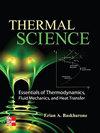Thermal characteristics of combined compressor - ejector refrigeration/heat pump systems for HVAC&R
IF 1.1
4区 工程技术
Q4 THERMODYNAMICS
引用次数: 0
Abstract
Thermal characteristics of combined compressor - ejector refrigeration/heat pump systems applied in heating, ventilation, air conditioning and refrigeration (HVAC&R) of buildings are investigated. An original model for estimation of the thermal characteristics of the combined cycles is developed, to determine the influence of the evaporation, interstage, condensation, and generating temperature conditions on mechanical and thermal COPs of the combined system, and to optimize the thermal parameters of the cycle. Results are presented for different temperature conditions, with R134a as a suitable refrigerant. A comparison between the thermal characteristics of the simple mechanical vapor compression cycle, the simple ejector thermocompression cycle, and the combined compressor - ejector refrigeration / heat pump cycle is given. The benefits of implementation of combined compressor - ejector refrigeration/heat pump cycles in HVAC&R systems are discussed. The temperature lift or temperature difference between condensing temperature and interstage temperature significantly influences the thermal (ejector) coefficient of performance. If temperature lift is between 10 K and 20 K, high values of thermal COPs can be achieved (0.5?1.0, for generating temperature equal to 80?C; 1.0?1.8, for generating temperature equal to 120?C); If temperature lift is between 30 K and 40 K, very low values of COPth can be obtained (0.05?0.3). High values of mechanical COPs can be achieved (24.8?6.9), for compressor stage temperature lift 10?30 K.HVAC&R用压缩机-喷射器组合制冷/热泵系统的热特性
研究了用于建筑采暖、通风、空调和制冷(HVAC&R)的压缩机-喷射器联合制冷/热泵系统的热特性。建立了一个估算联合循环热特性的原始模型,以确定蒸发、级间、冷凝和生成温度条件对联合系统的机械和热cop的影响,并优化循环的热参数。以R134a为合适的制冷剂,给出了不同温度条件下的结果。比较了简单机械蒸汽压缩循环、简单喷射器热压缩循环和压缩机-喷射器联合制冷/热泵循环的热特性。讨论了在HVAC&R系统中实施压缩机-喷射器制冷/热泵联合循环的好处。温度升程或冷凝温度与级间温度之间的温差显著影响热(喷射器)性能系数。如果温度升程在10 K到20 K之间,可以实现高的热cop值(0.5 ~ 1.0),产生的温度等于80℃;1.0 ~ 1.8,用于产生温度等于120℃);当温度升程在30 ~ 40 K之间时,COPth值很低(0.05 ~ 0.3)。当压缩机级温升为10℃时,机械cop值可以达到很高(24.8 ~ 6.9)。30 K。
本文章由计算机程序翻译,如有差异,请以英文原文为准。
求助全文
约1分钟内获得全文
求助全文
来源期刊

Thermal Science
工程技术-热力学
CiteScore
2.70
自引率
29.40%
发文量
399
审稿时长
5 months
期刊介绍:
The main aims of Thermal Science
to publish papers giving results of the fundamental and applied research in different, but closely connected fields:
fluid mechanics (mainly turbulent flows), heat transfer, mass transfer, combustion and chemical processes
in single, and specifically in multi-phase and multi-component flows
in high-temperature chemically reacting flows
processes present in thermal engineering, energy generating or consuming equipment, process and chemical engineering equipment and devices, ecological engineering,
The important characteristic of the journal is the orientation to the fundamental results of the investigations of different physical and chemical processes, always jointly present in real conditions, and their mutual influence. To publish papers written by experts from different fields: mechanical engineering, chemical engineering, fluid dynamics, thermodynamics and related fields. To inform international scientific community about the recent, and most prominent fundamental results achieved in the South-East European region, and particularly in Serbia, and - vice versa - to inform the scientific community from South-East European Region about recent fundamental and applied scientific achievements in developed countries, serving as a basis for technology development. To achieve international standards of the published papers, by the engagement of experts from different countries in the International Advisory board.
 求助内容:
求助内容: 应助结果提醒方式:
应助结果提醒方式:


